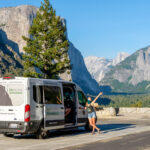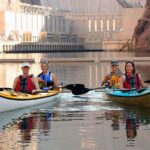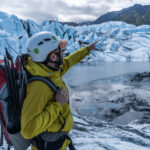Off the eastern edge of El Capitan flows a small but significant stream. Within the crevices of the granite cliffside, Horsetail Falls has a knack for hiding, yet in a couple of weeks it will take center stage as the greatest spectacle for those visiting Yosemite National Park.
What is Firefall?
Firefall is a natural phenomenon that happens every late winter/early spring in Yosemite National Park. As the sun begins to set, Horsetail Falls becomes a thin ribbon of embered orange with hues of red, cascading to the valley floor. This mystical glow is a timely manner, only striking for 2 weeks in February, 10-15 minutes before the sun fully disappears behind towering rock faces. This year, the naturally occurring Firefall starts February 14, 2020.
The Firefall is a fickle phenomena as several variables must perfectly converge. There must be enough snow melt where Horsetail Falls is actually flowing, but this fall has a peak flow season of December through April, keeping chances quite high. Furthermore, the sky must be crystal clear at sunset. Even subtle clouds can block sun rays from making their way through to the falls. When nature harmoniously merges during this time, visitors are left with one of Yosemite’s breathtaking sights adding to the supernatural effect of the park.’

The History of Firefall in Yosemite
‘Last Light on Horsetail Falls‘ is the first known photograph to capture the Firefall in all its vivid glory. Taken in 1973 by Galen Rowell, a National Geographic photographer, the photograph made the annual event a bucket list view for aspiring photographers, and outdoor enthusiasts alike. “The most interesting parts of the natural world are the edges, places where ocean meets land, meadow meets forest, timberline touches the heights,” stated Rowell, or in this case where sun meets water.

Although the name is reminiscent of the spectacle’s similarity to the golden blaze of summer bonfires, the naturally occurring Firefall inherited its name from a Yosemite tradition dating back to the nineteenth century.
A small inn, known as ‘The Mountain House’ was built at the top of Glacier Point in 1873. It served as a resting place for those traveling James McCauley’s toll trail from Yosemite Valley to the base of Sentinel Rock, a route now known as ‘The Four Mile Trail’ and one of the valley’s most popular hikes. The building of ‘The Mountain House’ and the addition of The Glacier Point Hotel in 1917 made the area more suitable for travelers, growing in popularity. As a form of summer entertainment, large bonfires were built during the evenings with red fir bark on the edge of Glacier Point. As flames gave way and the night continued to darken, piles of crimson embers were pushed over the edge, creating a steady flow of light.
To view a stream of fire tumbling down 3,000 feet became a sought-after event from Camp Curry (now Curry Village) down in the valley. Starting in 1872, the event became a ritual, occurring every evening at 9:00pm until it’s last descent in January 1968. After almost a century, the park service banned the firefall event due to its unnatural essence and severe damage among local meadows.
How to see Firefall this February
Despite the end of an era with the man-made firefall tradition, the history lives on each February as visitors flock to witness the grandeur of it’s natural replacement. Let us take you to see the Yosemite Firefall this winter! This year the Firefalls are scheduled to occur February 14th through 27th, and luckily we still have hotel rooms available within the Valley.

There are two ways to experience this must-see phenomenon: Take the trip at your own pace and book a hotel room or join one of our tours to receive both transportation, a guided tour of Yosemite Valley and a hotel room.
Here are more details on how to secure your spot:
1. Book a hotel room and self-drive to the park
It is recommended to stay in Yosemite Valley when viewing Firefall. With the additional visitors during this time period and a lack of parking, staying within Yosemite Valley is the most convenient option. These rooms book up fast online, but we still have a few rooms available at a few of our preferred accommodation options: Yosemite Valley Lodge and the Half Dome Village Tent Cabins (weekends only through winter).
Check our hotels page to see live availability for both of those hotels and to find out more information. Remember, book quickly for the 2020 event!
2. Take in the sights as you journey to Yosemite on one of our tours!
Our Yosemite Winter Hotel Tour covers your transportation to and from Yosemite, letting you focus on the snow-capped mountains rather than the winding roads. Enjoy a full afternoon of roaming the valley, cross Firefall off your bucket list, and wake up to the morning light gushing over Half Dome.
Yosemite National Park in February is as good as winter gets!








